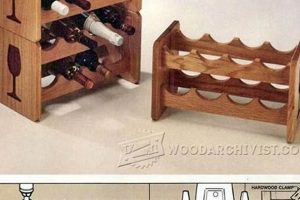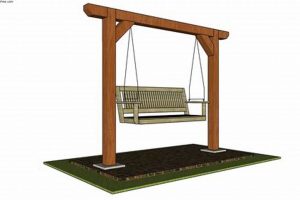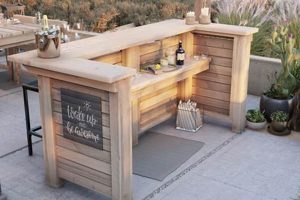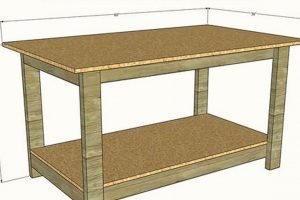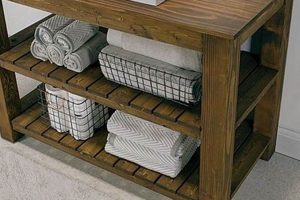Constructing a personalized burial container involves engaging with readily available instructions and designs for self-made receptacles intended for final disposition. These schemes provide guidance on material selection, assembly techniques, and customization options for creating a vessel typically associated with professional funeral services. An example would be acquiring a woodworking blueprint specifying dimensions, wood types, and joinery methods for a rectangular box suitable for holding human remains.
Creating a final resting place offers a significant opportunity for personalization and cost reduction compared to purchasing through conventional channels. This practice allows individuals to exert direct control over the aesthetics and materials used, reflecting the deceased’s values or preferences. Historically, crafting one’s own burial container was a common practice, demonstrating a connection to ancestral traditions and a desire for greater agency in end-of-life arrangements. Furthermore, it often presents a more economical alternative to commercial offerings, especially for those seeking simple and dignified options.
The subsequent discussion will explore key considerations when undertaking this project, including legal requirements, material selection criteria, construction methodologies, and finishing techniques. Emphasis will be placed on ensuring both structural integrity and adherence to any applicable regulations governing burial practices.
Guidance for Constructing Personalized Burial Containers
The following points offer crucial guidance for those considering the creation of a self-made burial container, emphasizing structural integrity, legal compliance, and aesthetic considerations.
Tip 1: Material Selection: Prioritize durable and environmentally compatible materials. Untreated softwood, such as pine or cedar, offers a balance of affordability and biodegradability. Avoid chemically treated lumber or composite materials that may pose environmental hazards during decomposition.
Tip 2: Adherence to Legal Requirements: Thoroughly research and comply with all local and state regulations concerning burial container specifications. Some jurisdictions mandate specific dimensions or material requirements to ensure proper handling and ground integrity.
Tip 3: Structural Integrity: Employ robust construction techniques, such as mortise-and-tenon or dovetail joinery, to ensure the container can withstand the weight of the interred and the pressure of the surrounding earth. Reinforce corners and edges with metal brackets or wood supports for added stability.
Tip 4: Accurate Measurement and Dimensions: Precisely measure the intended occupant to ensure adequate internal space within the container. Add a reasonable allowance for clothing or shrouds. Internal dimensions should comfortably accommodate the deceased without excessive space.
Tip 5: Secure Closure Mechanism: Implement a reliable closure system, such as screws, bolts, or latches, to prevent unintentional opening after interment. The closure mechanism should be discreet and aesthetically consistent with the overall design.
Tip 6: Interior Lining and Padding: Line the interior with natural fabrics, such as cotton or linen, to provide a comfortable and dignified resting place. Consider adding padding or cushioning for enhanced support and aesthetics.
Tip 7: Finishing and Decoration: Apply non-toxic finishes, such as natural oils or waxes, to protect the wood and enhance its appearance. Personalize the container with engravings, carvings, or artwork that reflect the deceased’s interests or values.
Adherence to these guidelines will contribute to creating a dignified, structurally sound, and legally compliant burial container that reflects personal values and preferences.
The subsequent section will address common challenges encountered during the construction process and offer potential solutions.
1. Material Durability
Material durability represents a critical factor in the context of self-constructed burial containers. The selected materials directly influence the structural integrity, longevity, and environmental impact of the final product. Choosing appropriate materials is paramount to ensuring the container adequately serves its purpose during interment and subsequent decomposition.
- Wood Species Selection
The choice of wood species significantly impacts durability. Softwoods like pine are readily available and cost-effective but may be less resistant to decay than hardwoods such as oak or cedar. While hardwoods offer enhanced durability, they are often more expensive and may present challenges in terms of workability. Cedar, for instance, possesses natural insect-repellent properties, contributing to increased longevity in soil environments, but its cost may be prohibitive for some applications.
- Resistance to Environmental Degradation
Burial containers are exposed to soil moisture, microbial activity, and pressure from the surrounding earth. Materials must withstand these environmental factors to prevent premature degradation. Untreated wood is susceptible to rot and insect infestation, whereas treated lumber may contain chemicals that impede natural decomposition processes. The application of natural preservatives, such as linseed oil or beeswax, can enhance resistance without compromising biodegradability.
- Structural Load-Bearing Capacity
The materials must possess sufficient strength to support the weight of the deceased and any overlying soil. Insufficient load-bearing capacity can lead to structural failure, compromising the integrity of the container. The thickness and density of the chosen wood directly correlate to its ability to withstand compressive forces. Implementing reinforced joints and supports can mitigate the risk of collapse.
- Long-Term Decomposition Characteristics
The manner and rate at which materials decompose contribute to environmental sustainability. Biodegradable materials, such as untreated wood and natural fabrics, promote natural decomposition processes. Conversely, synthetic materials and chemical treatments can persist in the soil for extended periods, potentially causing environmental harm. Selecting materials that decompose readily minimizes the long-term impact on the surrounding ecosystem.
In summation, the selection of durable materials for self-constructed burial containers involves a careful balance between structural integrity, resistance to environmental degradation, and long-term decomposition characteristics. Choosing appropriate materials not only ensures the container adequately serves its intended purpose but also minimizes its environmental footprint.
2. Structural Integrity
Structural integrity represents a paramount consideration in the execution of self-initiated burial container projects. The ability of a receptacle to withstand external forces and maintain its form directly impacts its intended purpose: the secure and respectful containment of human remains during interment. A failure in structural integrity can lead to a compromised burial, potentially causing distress and violating ethical considerations. The relationship between sound construction and the dignity afforded to the deceased is direct and unavoidable.
Several factors contribute to the structural stability of a self-built burial container. Material selection plays a critical role; the choice of wood, its thickness, and its inherent strength directly influence the container’s ability to bear weight and resist pressure from the surrounding soil. Equally important are the joinery methods employed. Weak or poorly executed joints constitute a primary point of failure, potentially leading to collapse under stress. Reinforcement strategies, such as the addition of internal bracing or external supports, can enhance the overall resilience of the structure. For example, dovetail joints, renowned for their strength and interlocking nature, provide superior resistance compared to simple butt joints. Likewise, strategically placed metal brackets can reinforce vulnerable corners and edges.
In summation, structural integrity is not merely a technical detail but a fundamental requirement for ethical and practical success in self-constructing a burial container. A lack of attention to material selection, joinery techniques, and reinforcement strategies undermines the purpose of the project and potentially results in an undignified outcome. Prioritizing structural stability ensures the creation of a secure and respectful final resting place.
3. Legal Compliance
The intersection of self-constructed burial containers and legal compliance presents a complex landscape demanding careful navigation. Regulations governing interment vary considerably across jurisdictions, encompassing material specifications, dimensional limitations, and handling protocols. Ignorance of these stipulations can result in legal repercussions, including rejection of the container at the burial site or potential fines. A cause-and-effect relationship exists: the decision to construct a burial container independently necessitates a proactive investigation into applicable statutes. For example, some localities mandate that containers meet specific minimum dimensions to ensure proper ground maintenance and prevent soil subsidence. Failing to adhere to these dimensional requirements could lead to rejection by cemetery authorities.
Continued adherence to legal guidelines constitutes an indispensable component of any self-construction project. This not only prevents legal complications but also ensures the respectful and dignified treatment of the deceased. Examples of practical applications of this understanding include contacting local zoning boards or cemetery administrations to ascertain precise requirements before initiating construction. Furthermore, documenting the materials used and construction methods employed can provide evidence of compliance in the event of an inquiry. The consequences of non-compliance extend beyond legal penalties; they encompass ethical considerations related to respecting local customs and traditions surrounding burial practices.
In conclusion, legal compliance is inextricably linked to the responsible execution of self-constructed burial container projects. This necessitates a proactive approach, involving thorough research and adherence to all applicable regulations. Challenges may arise from the variability of regulations across jurisdictions and the potential for ambiguity in legal language. However, by prioritizing legal adherence, individuals can ensure that their efforts result in a final resting place that is both personalized and legally sound, thereby upholding the dignity of the deceased and respecting community standards.
4. Internal Dimensions
Within the realm of constructing self-made burial receptacles, the determination of internal dimensions constitutes a critical stage. These measurements dictate the adequacy of the container to accommodate the deceased comfortably and respectfully. Overlooking this aspect can lead to significant challenges and necessitate costly rework or compromise the dignity of the interment process. The following outlines key considerations regarding internal dimensions within DIY casket plans.
- Accurate Measurement of the Intended Occupant
Precise measurements of the individual for whom the container is intended are paramount. These measurements should encompass height, shoulder width, and chest depth. An allowance for clothing or shrouds should also be incorporated to ensure adequate space within the receptacle. Failure to account for these factors can result in a container that is too small, necessitating alterations or requiring the deceased to be placed in an unnatural or uncomfortable position.
- Adherence to Regulatory Requirements
Certain jurisdictions may stipulate minimum internal dimensions for burial containers. These regulations are typically designed to ensure proper handling and ground integrity. Compliance with these requirements is essential to avoid legal complications and ensure acceptance of the container at the burial site. Researching local ordinances is a prerequisite to establishing appropriate internal dimensions.
- Consideration of Interior Padding and Linings
The inclusion of interior padding and linings impacts the effective internal space available. The thickness of these materials should be factored into the overall dimensions to prevent the container from becoming overly restrictive. The use of thick padding or multiple layers of lining can significantly reduce the available space, potentially compromising the comfort and dignity of the deceased.
- Provision for Handles and Lifting Mechanisms
The design of handles or lifting mechanisms may require additional internal space to accommodate their attachment points. Internal reinforcement structures to support these mechanisms can also encroach on the available space. Careful planning is necessary to integrate these elements without compromising the primary function of accommodating the deceased.
Proper consideration of internal dimensions is vital for the successful execution of DIY casket plans. A well-planned and accurately sized container ensures a dignified and respectful final resting place while mitigating the risk of complications arising from regulatory non-compliance or inadequate accommodation. The relationship between internal dimensions and the overall success of the project is direct and undeniable, and careful attention to this aspect is essential.
5. Closure Security
The integrity of a self-constructed burial container’s closure mechanism is of paramount importance. Closure security ensures the dignified and undisturbed containment of remains following interment. A compromised closure can lead to distressing consequences, including exposure of the deceased or disturbance of the burial site, underscoring the necessity of robust and reliable fastening methods within DIY casket plans.
- Latch Integrity and Durability
The choice of latch hardware significantly impacts closure security. Latches should be constructed from durable materials resistant to corrosion and capable of withstanding significant force. Examples include heavy-duty metal latches with secure locking mechanisms. The number and placement of latches should be strategically determined to distribute pressure evenly across the lid and prevent warping or separation. A single, weak latch offers inadequate security compared to multiple robust latches.
- Fastener Type and Placement
Screws, bolts, or other fasteners used to secure the lid must be appropriately sized and spaced to provide adequate holding power. Wood screws should be of sufficient length to penetrate deeply into the underlying wood, while bolts should be secured with washers and nuts to prevent loosening over time. The placement of fasteners should avoid areas prone to stress concentration or wood splitting. For instance, pre-drilling pilot holes before inserting screws can prevent wood from cracking, thereby enhancing fastener security.
- Sealant Application for Environmental Protection
The application of a sealant or gasket between the lid and the container body can enhance closure security by preventing the ingress of moisture and soil. A tight seal minimizes the risk of water damage to the interior and prevents soil from contaminating the burial site. Sealants should be selected for their compatibility with the construction materials and their resistance to degradation in soil environments. Silicone-based sealants or rubber gaskets are commonly employed for their durability and effectiveness.
- Tamper-Evident Features and Security Measures
Consideration should be given to incorporating tamper-evident features into the closure design. These features can provide a visual indication if the container has been opened or tampered with after interment. Examples include security seals or uniquely numbered fasteners. Such measures can provide reassurance to family members and deter unauthorized access to the burial site. The complexity of these features should be balanced with the practicality of construction within the context of DIY casket plans.
The implementation of secure closure mechanisms within self-constructed burial containers directly contributes to the preservation of dignity and respect for the deceased. Neglecting this aspect can undermine the integrity of the burial and create potential for distress. Therefore, a thorough assessment of closure security requirements and the selection of appropriate hardware and construction techniques are essential components of responsible DIY casket plans.
6. Personalization Options
Within the framework of “diy casket plans,” personalization options represent a significant departure from standardized, commercially produced burial containers. The ability to customize every facet of the final resting place provides a tangible means of reflecting the deceased’s unique life, values, and personality. This customization extends beyond mere aesthetics; it encompasses material selection, construction techniques, and the integration of symbolic elements that hold personal meaning. For instance, a woodworking enthusiast may construct a casket using timber harvested from their own property, while an artist might adorn the interior with hand-painted murals depicting scenes from their life. The cause-and-effect relationship is clear: the desire for a highly personalized memorial directly fuels the selection and execution of specific design choices within the project. The absence of personalization options transforms the process into a purely functional exercise, devoid of emotional connection and meaningful expression.
The importance of personalization stems from the deeply human need to commemorate and celebrate the lives of loved ones. Standard caskets, while often aesthetically pleasing, may fail to capture the essence of the individual they are intended to honor. Self-constructed containers, on the other hand, offer unparalleled opportunities for incorporating personal touches. Examples include embedding cherished photographs, handwritten letters, or symbolic objects within the lining of the casket. Families can also collaborate on the construction process, transforming it into a shared experience of remembrance and grief processing. The practical significance of this understanding lies in its ability to empower individuals to create a truly unique and meaningful tribute, fostering a sense of closure and connection during a difficult time. The resulting memorial serves not only as a final resting place but also as a lasting testament to the individual’s life and legacy.
In conclusion, personalization options are integral to the ethos of “diy casket plans,” enabling the creation of highly individualized and meaningful memorials. The careful consideration of design choices, material selection, and symbolic elements allows for a level of customization unattainable with commercially produced caskets. While challenges may arise in balancing personal expression with structural integrity and legal compliance, the potential benefits of a personalized burial container far outweigh the difficulties. The resulting memorial serves as a powerful and lasting tribute, providing comfort and solace to those left behind and ensuring that the deceased is remembered in a way that truly reflects their unique life and character.
Frequently Asked Questions
This section addresses common inquiries regarding the construction and utilization of self-made burial containers. It aims to provide factual and objective information, clarifying misconceptions and addressing potential concerns.
Question 1: Is constructing a burial container legally permissible?
The legality of constructing and utilizing a self-made burial container varies significantly by jurisdiction. Local and state regulations dictate specific requirements concerning materials, dimensions, and handling procedures. A thorough investigation into applicable laws and cemetery regulations is imperative before initiating any construction project.
Question 2: What materials are suitable for constructing a burial container?
Appropriate materials should possess both structural integrity and biodegradability. Untreated wood, such as pine, cedar, or poplar, is commonly employed. Chemically treated lumber or composite materials are generally discouraged due to potential environmental concerns. Natural fabrics, such as cotton or linen, are suitable for interior linings.
Question 3: How can structural integrity be ensured?
Robust construction techniques, such as mortise-and-tenon or dovetail joinery, are essential for ensuring structural integrity. Reinforcement measures, including metal brackets or wood supports, can enhance stability. The container must be capable of withstanding the weight of the deceased and the pressure of the surrounding earth.
Question 4: What are the recommended internal dimensions for a burial container?
Internal dimensions should comfortably accommodate the deceased, allowing for clothing or shrouds. Precise measurements of the intended occupant are necessary to determine adequate dimensions. Regulatory requirements may also stipulate minimum internal dimensions.
Question 5: How can closure security be guaranteed?
Secure closure mechanisms, such as screws, bolts, or latches, are necessary to prevent unintentional opening after interment. The closure system should be discreet and aesthetically consistent with the overall design. Tamper-evident features can provide added security and reassurance.
Question 6: Are there any environmental considerations associated with self-made burial containers?
Environmental considerations are paramount. Selecting biodegradable materials minimizes the environmental impact of decomposition. Avoiding chemically treated lumber and synthetic fabrics promotes natural decomposition processes. The use of non-toxic finishes and preservatives is recommended.
This FAQ provides a foundational understanding of key considerations. Detailed research and consultation with relevant authorities are essential before undertaking any DIY casket plans.
The subsequent section will explore ethical considerations surrounding this practice.
DIY Casket Plans
This exploration of diy casket plans has underscored the multifaceted nature of constructing personalized burial receptacles. Key considerations encompass legal compliance, material selection, structural integrity, dimensional accuracy, closure security, and personalization options. These elements interrelate, demanding careful planning and execution to ensure a dignified and legally sound final resting place.
The decision to engage with diy casket plans warrants thoughtful deliberation, acknowledging the inherent responsibilities and ethical considerations. Undertaking such a project signifies a commitment to honoring the deceased’s memory through personalized craftsmanship. The diligent application of knowledge, adherence to regulations, and respect for the gravity of the undertaking are paramount.


